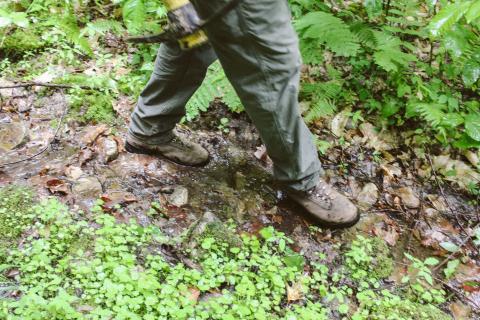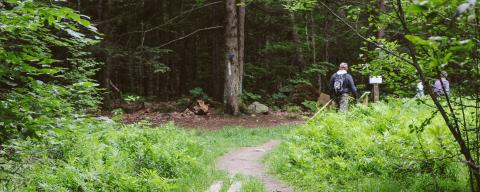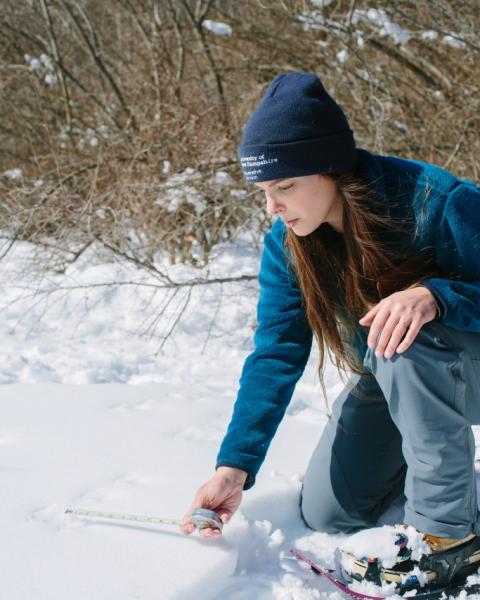Published August, 2022
Written by: Malin Clyde and Molly Donovan
Edited by: Charlotte Thompson
Project Background
Use of outdoor recreational trails increased dramatically during the COVID-19 pandemic, with some research indicating a 79% increase in trail use. Outdoor recreation participation rates for all activities increased 52.9% for US residents in 2020, the largest one-year jump on record. Trails in New Hampshire were also impacted, with community members, local land trusts, and state and federal agencies reporting increased trail use and stewardship challenges including increased trash, human waste, and parking congestion.
To address these concerns in Coös County, the Neil and Louise Tillotson Fund of the NH Charitable Foundation released a request for proposals in July, 2021. A team of researchers at the University of New Hampshire Cooperative Extension were selected to understand the key issues, constraints, and challenges to the stewardship of human-powered recreational trails in Coös County. The team was charged with synthesizing other trail stewardship approaches and models to identify successes, failures and key components. The team was asked to compile a set of tools and resources to support Coös trail stakeholders with trail stewardship solutions based on best practices, other successful models, and unique attributes of Coös County.
The UNH Extension team drew staff expertise from their Natural Resources, Community and Economic Development, and Youth and Family program areas.
The following report shares the results of the research that took place October 2021 - June 2022, including interviews with trails organizations, professionals and volunteers, interviews with trail users, and research into other trails organizations and projects that offer - to the Coös County trails community - potential models and approaches for advancing trail stewardship in the region.
Engagement Techniques
The team designed a detailed engagement effort to gain a deeper understanding of the issues and opportunities for stewardship in Coös County. Key informant interviews were conducted with those who have knowledge and experience with trail stewardship. Trail intercept surveys were conducted to gather information from trail users. The data from these engagement efforts were used to inform the choice of stewardship models to review. The recommendations in this report are linked directly to information gathered from those interviews, surveys and reviews of stewardship models.
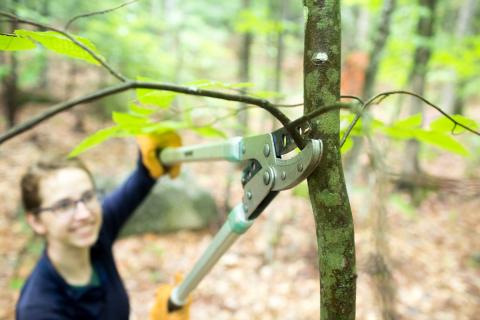
In the summary findings, major themes from the key informant interviews are paired with recommendations and researched models.
Link to related model for consideration
Summary Findings
Trail stewardship in Coös County is an important topic but not an urgent issue. The trail stewardship community is caring for trails in successful ways based on their current capacity. There is strong interest, sense of responsibility, and pride in caring for trails. Where specific trail stewardship deficiencies were mentioned, it was in reference to overuse of trails.
Local trail users are most interested and vested in trail stewardship. Improvements to trail stewardship efforts must be based in the activity of local groups and local efforts.
Recommendation: Focus stewardship attention on the busiest trails, exploring partnerships to help restore or fix problems on highly impacted areas. Consider prioritizing highly impacted trails and involving professionals for more complex work.
Several models show the success of coalitions among local groups: Bike Borderlands, Appalachian Trails Conservancy, Southern Maine Conservation Coalition, Upper Valley Trails Alliance.
See Upper Valley Trails Alliance for model of shared professional trail crew.
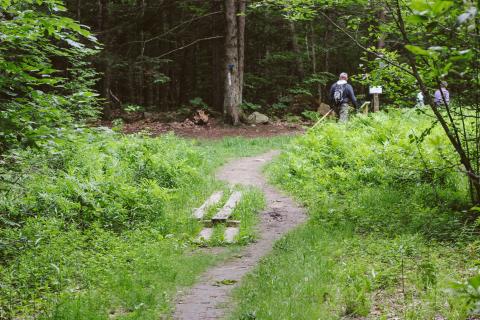
There is interest in mapping trails, tracking trail conditions, and mapping stewardship responsibility for trails.
Recommendation: Gather data on trail use to better understand use and anticipate stewardship needs.
Recommendation: Gather regularly updated data on trail organizations to understand capacity for trail stewardship and inform funding.
Recommendation: The trailhead surveys suggest that users are more than willing to participate in short surveys, which in the future could easily be conducted trained local volunteers. A more formal survey could clarify attributes of Coös trail users, their interests and barriers to volunteering, and could be an avenue for direct recruitment.
See Appalachian Trails Conservancy Regional Partnership Map as model for collating stewardship and organizational information; Bike Borderlands Maps as local, artsy example; Maine Trails Coalition Map for statewide focus on trail connectivity.
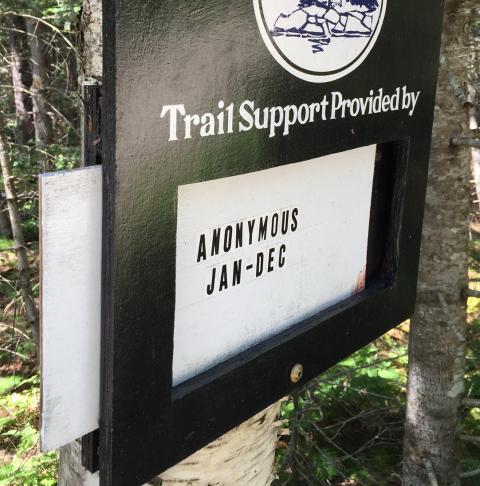
Trail Users
Trail user safety and user experience are incredibly important. Education of trail users (especially visitors and tourists) is needed to develop understanding of hiker responsibilities and norms for trail use and safety. Education will support trail stewardship and meet organizational commitments to provide a positive experience for all.
Recommendation: Local groups have a strong sense of responsibility for user safety and a high-quality experience. Focus on strengthening activities that promote user safety such as high-quality mapping (accessible to all), reliable signage and wayfinding, user education, and systems for reporting trail safety incidents. This was a strong and unexpected finding, and it’s recommended that this culture of responsibility for safety by local organizations be supported and strengthened.
Consider new ways to work with volunteers to accomplish other needs such a trail education and safety programs (see Appalachian Trails Conservancy Ridge Runners or Trail Ambassadors for models of trail education conducted by volunteers); also see HikeSafe training offered by National Park Service (available through Appalachian Trails Conservancy website) for safety of volunteers and the public.
Volunteers
Volunteer recruitment and training are an ongoing issue.
Recommendation: Look to strong models of volunteer training that could benefit multiple organizations.
Recommendation: Consider basic volunteer training to onboard new volunteer recruits with a focus on being easy and welcoming.
Recommendation: Locals are the most active users of the surveyed trails, suggesting trails have strong community value (vs destination tourism). Widen volunteer recruitment by targeting local community members (beyond membership of local trails groups). This approach may require more short-term opportunities that fit into busy schedules.
Recommendation: No information was gained about volunteer management practices such as formal recruitment, training, or recognition programs. This could be studied further through a simple survey or discussions to understand needs and interest for programming and training.
See Nature Groupie for resources and training on effective volunteer recruitment, working with volunteers, marketing and messaging. The events calendar shows volunteer opportunities on specific dates that allow potential volunteers to self-select based on their availability. Timing and type of experience are more important to outdoor volunteers than proximity (people will drive a long way) or the type of organization (most new volunteers don’t distinguish between organizations).
See Utah Trails Master Stewards program for volunteer training model.
See Appalachian Trails Conservancy’s biennial workshop for volunteer leaders.

Networking and Social Connections
Trail stewardship organizations value their members and volunteers. These connections add to the social fabric of organizations and communities.
Recommendation: The social and networking importance of organizational members and volunteers is important. Strengthening trail stewardship should continue to build on the strong network of local volunteers to build social capital in the community – look for models that involve networks of local organizations; look for ways to build the capacity of local organizations to increase local volunteers and membership.
See the Southern Maine Conservation Coalition as an example of a collaborative structure that designs education events to bring people together across local organizations to build community.
A model that combines the events calendar of Nature Groupie with the professional leadership of Volunteers for Outdoor Colorado where staff serve as the leaders of all projects listed on their calendar could increase the capacity of local groups and add professional skills.
Partnerships
There is a strong culture of building and benefiting from partnerships with the organizations doing trail stewardship in Coös County.
Recommendation: Inventory local businesses that are benefiting from trails to determine if they would partner on events, fundraising, or volunteer recruitment opportunities. The organizations interviewed are experienced with partnerships and this is an opportunity to expand partnerships to the private sector. With increasing discussion of trails as economic development assets, this is the time to begin to connect with businesses.
onsider an initiative to share content from Appalachian Trail Conservancy, Upper Valley Trails Alliance and Nature Groupie social media channels to build culture of stewardship among all groups and their users.
Volunteers for Outdoor Colorado and Upper Valley Trails Alliance for examples of local corporate sponsorship, including with the healthcare sector, keeping in mind that larger areas (Colorado) and larger coalitions may attract interest from larger corporations. Start with local businesses and build towards larger ones.
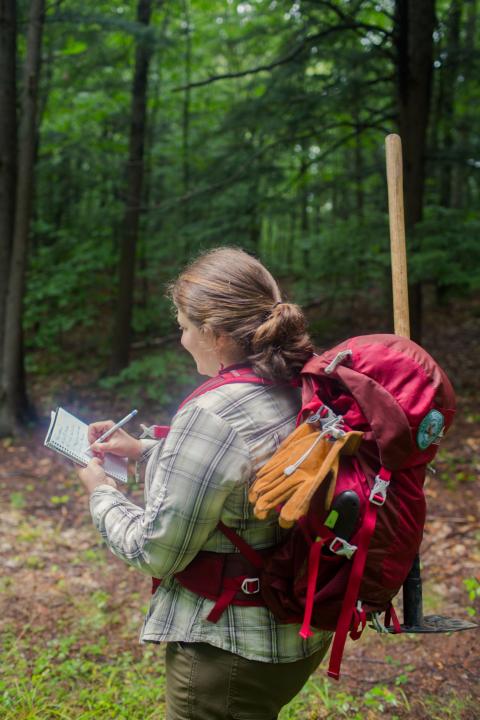
Organizational Capacity Building
Fundraising is an important component of trail stewardship. There are a variety of fundraising methods employed by the organizations in Coös County.
Recommendation: Interviewees understand “trail stewardship” as a wide-ranging set of activities, but the public likely does not, and doesn’t use this term.
Recommendation: The trails community is experienced with partnerships, which brings value. Look for ways to build on these partnerships through funding, collaboration, training, or recognition of these important connections across organizations in the region.
See Southern ME Conservation Coalition for collaborative approach for increasing capacity of many small groups, including fundraising.
Many of the models use the term “stewardship” - see ATC, Nature Groupie, Upper Valley Trails Alliance - especially with insider audiences (experienced volunteers, board members, etc.). When recruiting new volunteers and working with “outsider” audiences, use more specific and more welcoming language such as “volunteer action,” “caring for land,” “working on trails,” “improving trails,” “caring for trails,” “helping keep our lands open and safe.”
See Southern Maine Stewardship Collaborative, Upper Valley Trails Alliance for examples of local collaboration among groups.
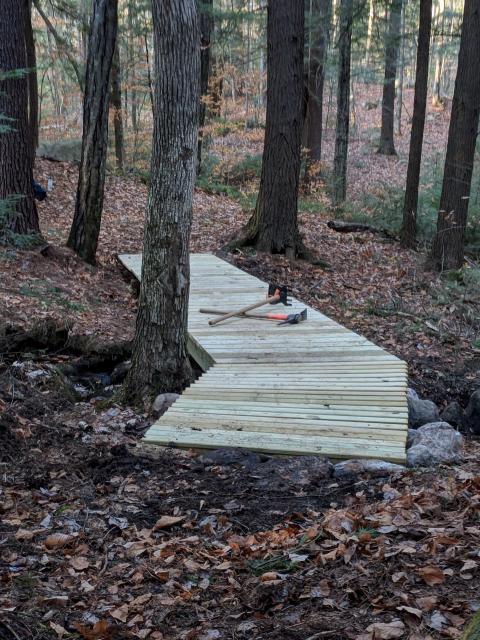
Key Informant Interview Methods
Methods
The research team used the key informant interview technique to identify crucial constraints, issues, and challenges to trail stewardship in Coös County. Key informant interviews are a qualitative research method using one on one interviews with community representatives who are knowledgeable on the research subject. Interviews are in a discussion format so varied information is reported. The interview can connect key informant and study leader to work toward solutions to the challenges being studied.
Key informants were identified by the research team in collaboration with the Tillotson team and included community stakeholders, land managers, trails groups, and municipalities. The team developed eight in-depth interview questions (see questionnaire in appendix). Interviewees were contacted via email and asked to participate in the study. Interviews were held via Zoom. To ensure the relative anonymity of those interviewed, all the information in this report is presented in the aggregate.
The team completed 23 interviews in January and February 2022. All interviewees are involved in trail stewardship in Coös County. The study includes 11 non-profit organizations, 4 municipalities, 3 state or local governments, 1 federal agency, 3 private companies and one other (see the list of organizations in the appendix).
Qualitative analysis was completed on all 23 transcripts using inductive coding. Inductive coding is a ground up approach, where the research team creates the codes (key words) based on the data. The codes are then grouped into themes, which are used to draw meaning and organize the ideas shared. Major themes represent ideas and information from across the questions and interviews, while sub-themes represent ideas and information from one or two interviews.
Key Informant Interview Themes
Trail Stewardship Organizations and Trail Stewardship Activities
Involvement in trail stewardship varied across organizations. Interviewees defined trail stewardship as their core mission or high priority, often citing their history and purpose of the organization. None of the interviewees indicated that trail stewardship was an urgent issue. Many noted the need to go slow and do their work well. Where there were concerns about trail stewardship it was usually in reference to not having enough volunteers to do the work: “we are limited by manpower and capacity.”
Interviewees defined trail stewardship broadly to include volunteer management, fundraising, trail events, and working with landowners and managers.
A few interviewees noted that they follow a specific plan or objectives, but this was not widely reported. Interviewees had an advanced and nuanced understanding of trail stewardship, as it encompasses a wide range of land management activities, including the following (ranked by number of responses).
- Signage
- Trail assessments, inventory, needs assessment
- Improve trails, reroute trails, open corridors, access issues
- Clearing drainage, culverts, water bars
- Coordinating volunteers and groups
- Portages
- Campsites
- Grooming
- Parking
- Porta potties
- Bike fix it station
- Trash
Volunteers and Staff
It is common to split work between volunteers and staff or paid professionals. Interviewees indicated that they use volunteers for basic work and staff or paid professionals for more complex or “higher level” stewardship activities. Terms like “basic maintenance,” “keeping trails passable,” “making sure there is signage” were used to describe work that can be done by volunteers. Volunteers are often the eyes and ears of organizations to report on conditions and trail needs. Some interviewees described having their volunteers adopt a property, but this was not widely reported. Interviewees cited the need for volunteer training and the need to recruit more volunteers.
Interviewees referenced a strong sense of connection to their volunteers and members. Organizations offering membership often noted that members are important as they pay dues in support of the organization.
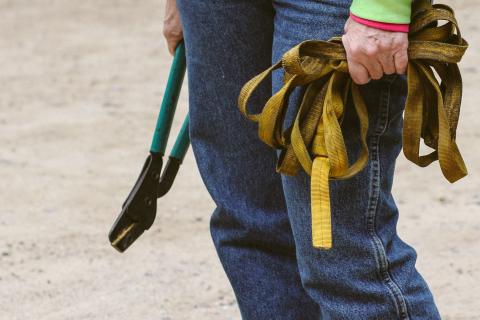
Stewardship Priorities
The organizations interviewed were very clear on their trail stewardship priorities. Safety was most widely cited as a priority. Specific comments include “safety is number one priority” “safety is the highest priority” and “lots of families use the trail so we want to make sure it is safe.” Environmental integrity and wildlife protection were second, and signage and blazing were third most cited. Other priorities shared (not ranked):
- Access
- Aesthetics
- Connectivity
- Erosion and water control
- Good experience and enjoyment
- Improve Google maps
- Parking
- Recreational uses
- Rehabilitation or construction of trails
- Support trail clubs
- Working forest
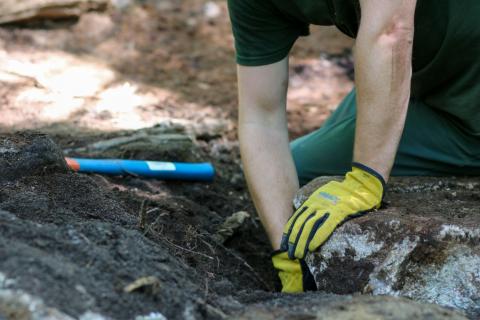
Organizational Capacity
When asked about how to enhance stewardship the following were mentioned by more than one interviewee (ranked):
- Funding for facilities such as parking, bathrooms, and signage
- More paid staff
- Inventory of trail conditions/master plan/plan for non-motorized trails
- Training for stewardship volunteers
- Educating users
- Trail maps
Across the 23 interviews, our research team found a wide variety of ways that organizations are raising funds to support trail stewardship. Most organizations are using multiple approaches. By far the most common form of fundraising is securing grants. These were reported as federal grants or foundation grants. We did not find a link between local businesses and financial support for trail stewardship. Only one interviewee cited town funds as financial support. Some reported wanting to hire professionals but noting the expense and lack of funds for this. Reported fundraising approaches (ranked by times cited):
Reported multiple times
- Grants/Foundations
- Donations
- Memberships
- Events
Reported by a single organization
- Town funds
- Revolving funds
- Merchandise
- Endowment
- License fee/registration fee
- Capital campaign
- Contracts
Partners and Partnerships
Partnerships are an important feature with the organizations doing trail stewardship. Over 30 different partners were cited, comprising a very strong list of national, regional, state and local organizations. There is exceptional variety within the local partnerships, and all partnerships were referenced in a very positive way.
Partnerships of trail stewardship organizations in Coos County:
Appalachian Mountain Club
Appalachian Trail Conservancy
Bike Groups
Brookfield Power
Chamber of Commerce
Cohos Trails Assn
Colebrook Library
Conservation Commissions
Cross New Hampshire Adventure Trail
Friend groups and organizations (ski clubs)
Gorham Land Company
Land Trusts (some larger, some local)
Moosebrook State Park
Municipalities
National Park Service
Northern Forest Center
Northwoods Stewardship Center (VT)
Private landowners
Running Clubs
Snowmobile groups
State of NH
State Trails Bureau
Student Conservation Association
Trail Clubs
Trust for Public Lands
US Fish & Wildlife Service
US Forest Service
Waterway stewards
White Mountain National Forest
White Mountain Trail Collective
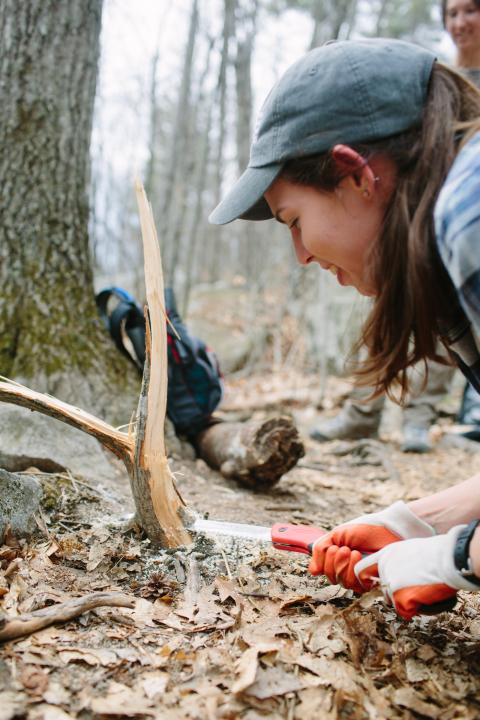
Challenges
No over-all theme or consensus emerged when interviewees were asked about challenges. Challenges were described in other questions such as trail user behavior, need for funding, lack of volunteers, need for skilled volunteers and parking. Other challenges included understanding wildlife habitat, over-use of trails, maintenance standards. Below are the challenges that were cited throughout the interviews:
- Volunteer recruitment
- User Education
- Skills training - it was noted that training can be siloed because individual organizations are doing it separately
- Funding - some noted the administrative burden with grants, another that the interest is there but not the funding
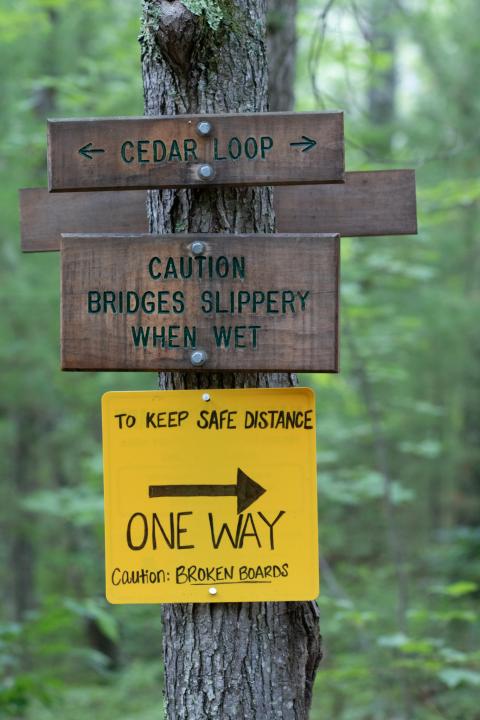
Individual challenges cited that may be of interest:
- Need for more paid staff positions but concern that using professionals will lead to loss of volunteer culture
- Plans are needed to connect trails
- Signage is needed
Interviewees were asked whether trails stewardship was needed, neglected, done well or done at all. The data shows that interviewees believe that trails are taken care of but areas of need remain. Many people noted that well-known hiking areas have local users to care for the trails, and that motorized trails get more attention than non-motorized. Older trails are more likely to be in disrepair.
When asked about who has the strongest interest in trail stewardship, the overwhelming response was that local trail users are the most interested and engaged. Findings from intercept surveys support the idea that Coös trails are most appreciated and used by Coös locals. There is high value for these users, and they are seen as stewards, whether caring for trails or just being the eyes and ears for conditions. Also noted was that there are local users that are not engaged in stewardship, and this is seen as an untapped opportunity.
The second most frequently cited group was landowners as they understand the needs the best. Finally, organizations responsible for stewardship are interested in keeping high standards, meeting their mission, and keeping their positive reputation. It was noted that tourists come for recreation and don’t always understand the stewardship needs. Businesses are not thinking about trail stewardship even if they are benefitting from trail users.
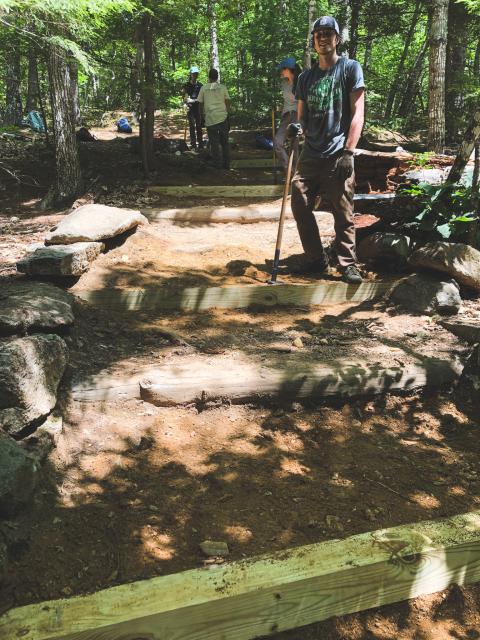
Trail Intercept Surveys
The team conducted two sessions of trail intercept surveys to test whether this approach offered new perspectives beyond information collected from key informant interviews. This effort was intended as a pilot effort, not designed to be comprehensive or statistically significant.
Methods
Based on recommendations from Tillotson Fund partners, interviews were conducted at two locations:
- Presidential Rail Trail Route 2 Parking Area, Gorham (February 22, 2022)
- Table Rock Trailhead, Dixville Notch (June 18, 2022)
Inclement weather during both scheduled survey dates led to light recreational use, but 100% of users present during the survey times agreed to participate in an interview. Interviewees were asked about their outdoor activities, what they knew about the land on which they were recreating, their experience with volunteerism and trail volunteering specifically. A list of intercept interview questions is included in the Appendix.
Results
A total of seven trailhead interviews were completed. Most users (86%) were from the local area and the average age was 35. About half (57%) accurately identified the owner or manager of the trail on which they were walking or hiking. Of their favorite outdoor recreational activities, hiking was the most common (86%), followed by mountain biking (57%), walking (43%) and water sports or canoeing (29%). All mentioned health, fitness or COVID-related escape as a reason for recreating outdoors. Other reasons include peace and quiet (43%) and wildlife (14%).
A few users consider themselves volunteers in their community (29%), but none had experience volunteering for trails. When asked if they would be interested in volunteering for trails, most expressed they were very busy, and one mentioned they wouldn’t know where to sign up. Interviewees had positive responses to the work of cycling clubs in maintaining trails in the area (especially around the Presidential Rail Trail), but in Dixville Notch, users expressed concern over a lack of signage, mapping, and confusion about land ownership.
Findings
Even with a small sample, it seemed that local users are important suggesting strong community value to these areas (as opposed to destination tourism). Similar to findings from other community trails in NH conducted by the research team, Coös trail users are often confused about who manages local trails.
Collaborative Models Research
A Toolbox for Improving Trail Stewardship in Coös County
Our team examined examples of conservation, trails, and stewardship efforts that use collaboration in different ways: across organizations, geographic regions, trail systems or agencies. Although initially the team assumed a single example might offer a model for Coös trails stewardship, after completing key informant interviews it became clear that the region may benefit from a variety of options for innovation, refinement and new ways of caring for trails. As a result, the analysis below offers a range of ideas drawn from the models, with ideas relevant to the needs of the Coös trails community. The idea is to build a unique set of relevant initiatives which we highlight as a “Coös Toolbox”.
Starting with a list of 10-12 possible models for review, the team worked with project leadership (Tillotson Fund staff and partners) to narrow the research to eight, based on the outcomes of the key informant interviews. Examples were chosen that emphasized local scales, creative approaches, or innovations that related to the needs identified by the interviewees. These included collaborative examples from both near (Coös and Grafton Counties) and far (Utah and Colorado), and those involving hundreds of organizations (Nature Groupie) and those involving fewer (Southern Maine Conservation Collaborative). One local example, the White Mountain Trails Collective, while included in our key informant interviews, was excluded from more in-depth research as it is undergoing a change in leadership and its management structure was unclear at the time of this research.

Appalachian Trails Conservancy (ATC)
Mission: To protect, manage and advocate for the Appalachian National Scenic Trail
Launched in 1925 as the Appalachian Trail Conference to build what is now the Appalachian Trail (AT), ATC has a 100-year legacy of partnership and collaboration in service to protecting and caring for the AT and surrounding landscapes. Management of the trail is overseen by the Stewardship Council, a subcommittee of the board made up of National Park Service and Forest Service staff, ATC staff, community volunteers, and representatives of the regional groupings of trails clubs (30 in total that care for the trail from Maine to Georgia). Management policies and decisions are managed through a Cooperative Management System (or “3-legged stool”) made up of the land owning agencies (National Park Service, Forest Service or other landowner), the 30 volunteer trail clubs, and Appalachian Trail Conservancy staff. As one insider explained it, “on paper, it doesn’t look like it would work, but it has for 100 years.” Decision making and changes to trail management and policy receive input and approval from all groups before being enacted. The ATC staff support the work of trail clubs by offering online and in-person training opportunities, hosting a biennial conference for trail volunteer leaders, and helping recruit volunteers through an online portal (modeled on the one used by Nature Groupie).
Coös Toolbox from ATC:
Complex Collaboration: A strong trails vision can bring many diverse interests to the table throughout long periods of time.
Mapping: ATC publishes an interactive map of the AT that shows the AT, which trail club is responsible for managing each section of the AT corridor, and designated “AT communities” such as Gorham, NH. See ATC Regional Stewardship Map.
Training: ATC offers professional, consolidated training for all trail club leaders through biennial Volunteer Leaders Conference. In addition, they offer online training modules that are available free to the public, for trails clubs to engage and train new volunteers, and themselves, including access to the National Park Service’s “Trail Safe” training aimed at improving safety in outdoor recreation and trail work.
Education: Some ATC trail clubs have Ridge Runner or Trail Ambassador programs where volunteers educate AT trail users on leave no trace and other educational messages (bear safe containers, staying on trail, etc.).
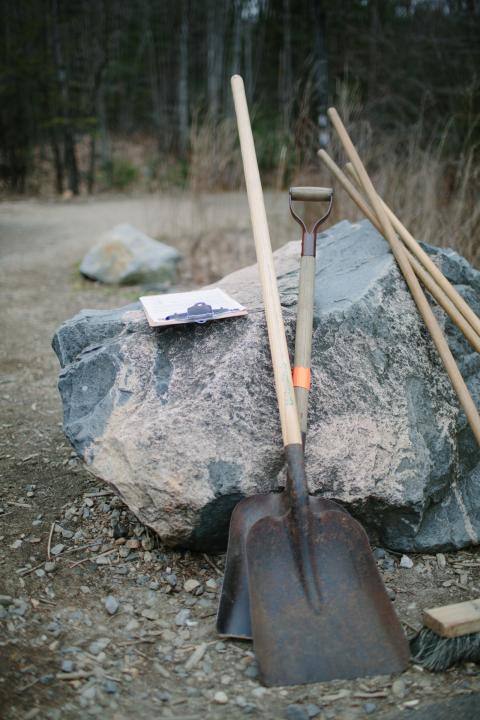
Bike Borderlands
Mission: Improving tourism and communities with cycling in NH, ME, VT and Quebec.
Launched in 2018 and coordinated by the Northern Forest Center, Bike Borderlands enhances recreation opportunities for local residents, attracts visitors to support local businesses, and is building the region’s reputation as a mountain biking destination. The main focus of the project is collaborative marketing and messaging for nine different mountain biking destinations. In addition, the initiative has strengthened local trail groups by providing small grants for trail construction, kiosks, maps, bridges and tools. A shared media campaign - #BikeWithGratitude – aims to build a respectful mountain biking culture, deemed to be “critical to the successful growth of this activity.” Trails club partners in the initiative include: Circuit Frontières (Quebec), Craftsbury Outdoor Center (VT), Kingdom Trails (VT), PRKR Mountain (Littleton, NH), Profile Trails (Franconia, NH), Coös Trails (Gorham, NH), Bethlehem Trails (Bethlehem, NH), Mahoosuc Pathways (ME), and Carrabassett Region NEMBA (ME).
Coös Toolbox from Bike Borderlands:
Marketing & Tourism: Bike Borderland offers a model for shared branding and marketing to a particular target audience (mountain bikers). The central role of the Northern Forest Center in providing staff, coordination, website content and small grants administration appears critical given the (small non-profit) nature of participating groups.
Small Grants for Infrastructure: Having a central organization to support simple, small infrastructure grants across the network of trails groups appears to be an effective strategy for improving local stewardship, especially infrastructure that supports a consistent user experience for all Bike Borderlands trail networks.
Maine Trails Coalition
Mission: To champion the establishment, use and stewardship of trails in Maine.
The Maine Trails Coalition was formed in 2019 to be a statewide voice for trail users, supporters, and advocates. Leadership is volunteer-only by 30 trails organizations (multiple scales and across all regions), most of which are private non-profits, but the coalition also includes the state office of recreation and the National Park Service. Recent initiatives include a statewide trails vision (May 2022) with a focus on large-scale Rail-to-Trails connections across the state, and a social media campaign for #LoveMaineTrails. The purpose of the coalition is to attract larger dollars – state or federal – to improve trail connectivity throughout the state and to provide a unifying vision for many/all organizations to work towards.
Coös Toolbox from Maine Trails Coalition:
Advocacy: If political advocacy is needed (for state or federal support, etc.), building a coalition with a strong vision can help move the needle for big ideas. Use of unified hashtag and connectivity map are main initiatives; requires strong organizations with staff time available to dedicate to broad trails advocacy and shared vision of all groups.
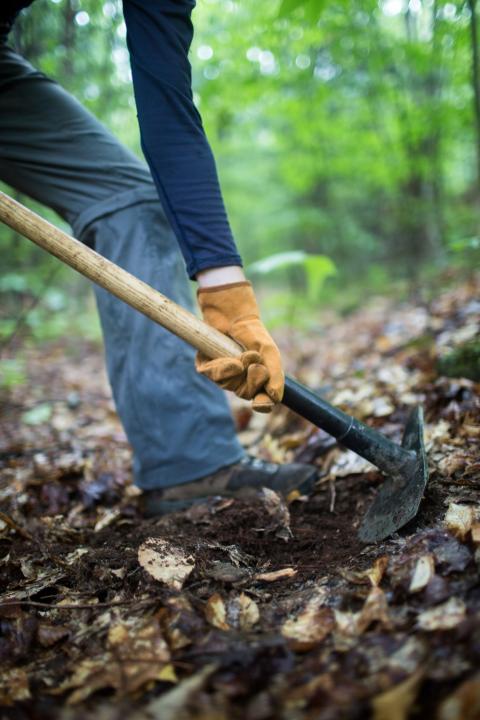
Nature Groupie
Mission: To empower generations of outdoor enthusiasts to volunteer for nature.
Nature Groupie is an initiative launched by UNH Cooperative Extension in 2014 that covers all of New England, but with its strongest focus in New Hampshire. The project includes a website and newsletter focused on recruiting volunteers on behalf of 400+ environmental organizations. Some describe Nature Groupie as “AirBnB for outdoor volunteering,” and its community tends to be digitally savvy. The project includes a tool sharing program in southern NH and eastern VT, volunteer training on stewardship topics (including trail maintenance for volunteers), and collective action on targeted invasive plants such as garlic mustard. The Nature Groupie community includes over 5,000 weekly subscribers who identify themselves as potential volunteers.
Coös Toolbox from Nature Groupie:
Volunteer Recruitment: Coos Trails groups could get help recruiting new volunteers by posting trails workdays or events on the Nature Groupie calendar. To date, only 2% of posted events have been in Coös County. Further, Nature Groupie research has shown that more than 50% of volunteers travel outside their home county to volunteer, so Coös groups could be attracting Nature Groupie volunteers from other regions.
Volunteer Training: Nature Groupie also offers training on basic trail maintenance for volunteers (online guides, partner for in-person trainings). More online training modules are planned.
Partnership: Nature Groupie offers a model of Extension providing services to address needs of multiple organizations in a region; consider further cooperation with Extension in Coös County.
Southern Maine Conservation Coalition (SMCC)
Mission: To work collectively in Maine to create mutually beneficial relationships with the earth, communities, and people through the conservation movement.
This coalition was founded in 2012 as a “service center” to assist small conservation groups in southern Maine with hands-on professional assistance. Current membership includes 15 conservation organizations, including land trusts, statewide conservation groups, and trails organizations. Two full time and two seasonal staff support the work of the organization, whose budget is approximately $163,000, raised through contract fees from members, grants and individual donations. The focus of work for the SMCC is varied according to the needs of each partner organization but includes event planning, fundraising assistance, marketing and communication assistance, strategic planning for boards, land conservation transaction assistance and help with volunteers. A recent major focus of SMCC has been providing educational workshops and resources related to diversity, equity, inclusion and justice (DEIJ), a shared need of the member organizations that has accelerated in recent years. In fact, SMCC has become a leader in DEIJ expertise for conservation in the region, offering a wide variety of innovative and original online trainings that support learning among the leadership and membership of the groups involved in the coalition (and beyond, as most are open to the public).
Coös Toolbox from Southern Maine Conservation Coalition
Collaboration: If many small organizations have need of small amounts of professional assistance, a shared staff can be an effective strategy, particularly in being responsive on emerging topics such as diversity, equity, inclusion and justice. However, SMCC has become as large or larger that some of its member groups, so sustaining the organization structure (a separate non-profit) requires a strong commitment of member groups.
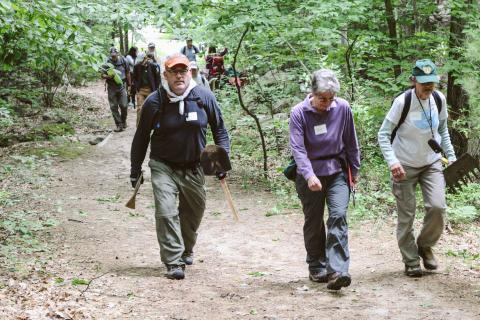
Upper Valley Trails Alliance (UVTA)
Mission: To advocate for the use, maintenance, and development of trails in the Upper Valley region of NH and VT.
The Upper Valley Trails Alliance was started in 1999 after a multi-community needs assessment showed trails as a mechanism for improving community health in the 43-town region. Today, UVTA uses education, outreach, and stewardship to promote “active lifestyles through trail use in all seasons,” and to connect people and places through a regional trail network. Partners in the UVTA include local conservation organizations, landowners, and towns, including volunteers. UVTA publishes and updates all local trails on TrailFinder, and publishes an annual map of impact on their website. A blog and newsletter promote trails, trail stewardship and user education. A signature program is their High School Trail Corps program, a summer stewardship crew led by UVTA staff that provides a stipend and school credit for participating local high school students. The budget of the UVTA is approximately $380,000 and supports 4 full-time staff based at their office in Norwich, VT. Their staff have professional trail stewardship skills and focus on planning, designing and helping build (or improve) trails for all the smaller groups and towns in the Alliance (sharing costs getting grants, providing youth Corp and volunteers). They also host a tool sharing program and negotiate trail easements on behalf of Alliance partners.
Coös Toolbox from Upper Valley Trails Alliance
Professionalism: UVTA staff are trails professionals who are available (often through grants or contracts) to work with local organizations or towns to improve, expand, or connect trails. With regional trail networks requiring long-term relationships and sustained effort, a professional and experienced organization can advocate on behalf of all-volunteer groups and town boards to accomplish long-term trails initiatives that might otherwise lose momentum.
Corporate Connections: UVTA has attracted non-traditional conservation partners including a wide range of corporate sponsors, possibly due to their commitment to broader community issues such as healthy living and positive youth development.
Utah Trail Master Stewards
Mission: To provide basic online volunteer training to improve the quality and maintenance of trails in Utah.
The Utah Trail Master Stewards Program is based out of Utah State University Extension and was developed and launched in 2020 at the request of the Utah Office of Outdoor Recreation. The modestly priced ($10) online training course serves as a prerequisite for more advanced, in-person trainings offered through Extension, which can culminate in participant’s receiving certification as a “Utah Trail Master Steward.” The introductory course is aimed at volunteers, trails organizations and land managers with a “foundational understanding of the values inherent in trail stewardship” and covers basic skills required to be a steward of Utah’s trail resources. All volunteers working on trails in Utah are encouraged (and often required) to take the online course before participating. The course teaches properties of a sustainable trail, trail design and planning processes, impacts related to unauthorized trail construction, key parts and functions of a typical trail, and the purpose and safe use of common hand tools used in trailwork.
Coös Toolbox from Utah Trail Master Stewards
Collaborative Training: Utah collaborated with Extension to produce and host a basic trail stewardship training course that could be used by any trail manager or trail club looking to engage new volunteers and establish consistency of trail stewardship standards.

Volunteers for Outdoor Colorado (VOC)
Mission: To motivate and enable people to become active stewards of Colorado’s natural resources.
Volunteers for Outdoor Colorado started in 1984 to help recruit, train and manage trail and stewardship volunteers on behalf of conservation land agencies (especially the US Forest Service, Bureau of Land Management and Colorado Parks). It has grown to include partnerships with CO-based conservation nonprofits, counties, and municipalities focused on stewardship, especially trail stewardship. VOC is recognized as a national leader in trail stewardship and volunteer engagement and employs 15 full time staff with a budget $1.14 million raised from government agencies (30%), individual donations (20%), corporate sponsors (22%), foundations (13%) and other (9%). VOC has been instrumental in ensuring that significant funding for stewardship in CO gets allocated from $140 million state lottery fund (“Great Outdoors Colorado”). Similar to Nature Groupie, VOC hosts a stewardship events calendar that makes it easy for volunteers to find and sign up for stewardship workdays. However, VOC staff serve as the leaders of all projects listed on their calendar, operating a more centralized, professionalized relationship with partners. Local partners work with VOC to execute stewardship projects on partner lands and trails, benefiting from VOC expertise and volunteers recruited through VOC outreach. VOC is a national leader in messaging about the importance of volunteerism, stewardship and trails to human well-being and to Colorado’s economy, particularly in the face of “near-crisis” levels of environmental impacts caused by increased population and recreational pressures in the state. VOC is also a source for stewardship training, sponsoring both an in-depth Outdoor Stewardship Institute and a (DIY) Stepping Up Stewardship program to train volunteers and professionals in stewardship skills, including courses in crew leadership, project management, working with youth, and trail design.
Coös Toolbox from Volunteers for Outdoor Colorado
Inspiration: VOC offers a vision for what dedicated organizational focus on trails and stewardship can lead to after 35 years. VOC projects fill up with volunteer sign-ups immediately after posting each season. Trail stewardship in Colorado attracts widespread public and private investment and is closely linked to economic growth and community well-being in both the media and among landowners and non-profits in Colorado. Professional leadership of projects and an emphasis on volunteer training and recognition are hallmarks of VOC’s work.
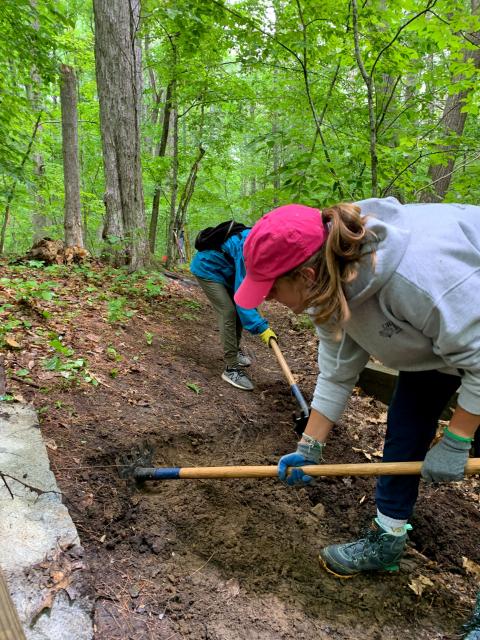
Appendix
Key Informant Interview Questions
- How is your organization involved in trail stewardship?
- What are your priorities? Do you work with partners?
- Tell me about taking care of trails in Coos County - Tell me is it needed, neglected, being done well or at all?
- Who is most interested in the trails being well maintained? Why? Are they actively working on it - why/why not?
- What are the challenges and tensions to maintaining and managing the trails in Coos County?
- How can trail stewardship be enhanced, strengthened, or done differently in the county? What is needed? (Prompt: volunteers, staff, training, tools, authority, coordination, funding or other).
- What other approaches have you seen work or not work – can you give some examples?
- What else can you share about the efforts to care for the trails in Coos County?
Trail Intercept Survey Questions
- Would you be willing to share your zip code of where you live?
- What kinds of outdoor activities do you like to do?
- What do you like about recreating outdoors?
- What can you tell me about this natural area or property?
- Do you know who owns the land here?
- Have you ever noticed any work that’s been done on this property?
- Are you someone who volunteers for things? If so, how have you volunteered?
- Have you ever helped do work on trails or land like this? Trash pick-up, clearing trails, etc.
- If so, what was the experience like?
- If not, would you consider volunteering to help properties or trails like this? Why or why not?
- Could you share the year you were born?
Key Informant Interview Participants
Organization names shared with permission
- Appalachian Mountain Club
- Cohos Trails Association
- Colebrook Rec. Department
- Coos Cycling Club
- Cross NH Adventure Trail
- Forester
- Fountains Land Inc / F and W Forestry
- Great Glen Trails
- Jefferson Conservation Commission
- Milan Community Forest
- Nansen Ski Club
- NH Division of Forests & Lands
- NH Fish and Game
- NH State Parks, Bureau of Trails
- Northern Forest Canoe Trail
- Randolph Community Forest, Coos Planning Board, Coos Conservation District
- Randolph Mtn Club
- Society for the Protection of NH Forests
- Town of Lancaster
- Visit Northern NH
- Wagner Forest Management (Bayroot LLC)
- White Mountain National Forest
- White Mountain Trails Collective
